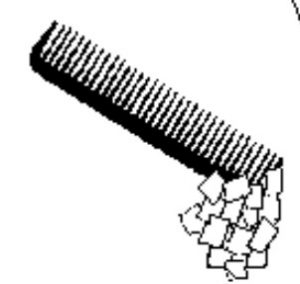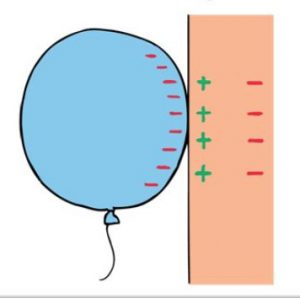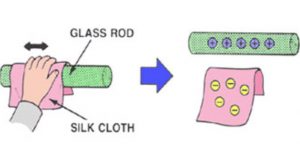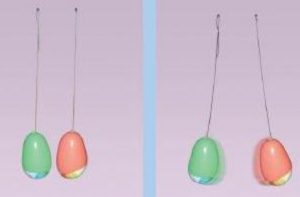Question 1 What are the two kinds of electric charges?
Question 2 Why does a plastic comb rubbed with dry hair attract tiny pieces of paper?
Question 3 What is lightning?
Question 4 Explain why a charged balloon is repelled by another charged balloon?
Question 5 Explain why a god rod can be charged by rubbing when held in hand but an iron rod cannot be charged by rubbing , if held by hand?
Question 6 How will you charge a glass rod by the method of friction?
Question 7 How will you charge an inflated rubber balloon by the method of friction?
Question 8 How will you charge a ball point pen by the method of friction?
Question 9 Explain why a charged body loses its charge when we touch it with our touch?
Question 10 A glass rod is rubbed with a silk cloth? What type of charge is acquired by silk cloth and glass rod?
Question 11 An inflated rubber balloon and a woollen cloth are rubbed together? What type of charge is acquired by (a) woollen cloth (b) rubber balloon
Question 12 What are static charges?
Question 13 “The glass rod is first rubbed with a piece of silk cloth and then brought near the tiny pieces of paper, then the glass rod attracts the tiny pieces of paper towards itself” Explain?
Question 14 What is meant by charging the object?
Question 15 Give an activity to show that like charges repel each other?
Question 16 Give an activity to show that unlike charges attract each other?
Contents
Lightning
Lightning is an electric spark on a huge scale which is caused by the accumulation of electric charges in the clouds. Electric charge is the property of matter which is responsible for electrical phenomena. Electric charge exists in two forms: positive electric charge and negative electric charge.
Electric Charge
A Greek scientist called Thales observed that when a material known as ‘amber was rubbed with a silk cloth, it started attracting tiny feathers. Thales said that amber acquires electric charge (or electricity) on rubbing with silk and the force of this electric charge attracts the tiny feathers.
Activity
We rub a plastic comb with our dry hair and bring it near tiny pieces of paper. We will find that the comb attracts the tiny pieces of paper towards itself. Due to this attraction, the tiny pieces of paper move towards the comb and stick to it. Actually, when we rub the plastic comb with our dry hair, the plastic comb gets electric charge due to friction. The electrically charged comb then exerts an electric force on the tiny pieces of paper and attracts them.
If we rub one end of a pen made of plastic with a sheet of paper (or even with our dry hair) for about one minute and then bring it near tiny pieces of paper, it attracts the tiny pieces of paper. Due to this attraction, the tiny pieces of paper stick to the pen. Here also the plastic pen gets electric charges on rubbing with a sheet of paper (or dry hair). The electrically charged pen then exerts an electric force on the tiny pieces of paper and attracts them.
If we take an inflated rubber balloon and rub it carefully with a piece of woollen cloth and then touch it with a wall, the balloon sticks to the wall. When we rub the rubber balloon with a woollen cloth, the rubber balloon gets electric charges due to friction. This electrically charged balloon then exerts an electric force of attraction on the wall due to which it sticks on the wall.
The electric charges which appear on a plastic comb or plastic scale (rubbed with dry hair), on plastic pen (rubbed with a sheet of paper) and on a rubber balloon (rubbed with a piece of woollen cloth) are the static electric charges (or stationary electric charges) which remain bound to the surface of an object and do not move. The static electric charges are also known as charges at rest.
Uncharged and Charged Objects
An object having no electric charge on it is called an uncharged object.
An object having electric charge on it is called a charged object.
A charged object attracts other uncharged objects.
If we take a glass rod and bring it near some tiny pieces of paper, it will not have any effect on them. If, the glass rod is first rubbed with a piece of silk cloth and then brought near the tiny pieces of paper, then the glass rod attracts the tiny pieces of paper towards itself.
Reason: The glass rod is electrically neutral or uncharged (having no electric charge), so it has no effect on the tiny pieces of paper. But when the glass rod is rubbed with silk cloth,
then it gets electric charge. The electrically charged glass rod exerts a force on the tiny pieces of paper and hence attracts them.
A glass rod rubbed with silk acquires the ability to attract small, uncharged pieces of paper.
The process of giving electric charge to an object is called charging the object.
Charging an Object by Rubbing (or Friction)
The method of charging an object is to rub it with another suitable object (such as silk cloth, woollen cloth, hair, paper or polythene, etc.). When an object is rubbed with another object, then there is friction between them. This friction charges the object.
The charging of an object by rubbing it with another object is called charging by friction.
(1) The charging of a glass rod by rubbing it with a silk cloth.
(2) When a plastic comb is rubbed with dry hair, the plastic comb acquires an electric charge due to friction.
(3) When a ball point pen refill is rubbed vigorously with a piece of polythene, the refill acquires electric charge by friction. The charged refill can attract tiny pieces of paper kept near it.
(4) When an inflated rubber balloon is rubbed with a piece of woollen cloth, it gets charged due to friction.
The electric charges generated by rubbing (or friction) are static electric charges.
These electric charges remain bound on the surface of the charged object They do not move by themselves.
All the insulator objects (like glass rod, plastic comb, plastic scale, plastic straw, ball pen refill and rubber ballon, etc.) can be charged by rubbing while held in hand. This is because being insulators , they do not conduct electric charges produced on their surface through our hand and body into the earth.
Conducting objects made of metals (like a steel spoon) cannot be charged by rubbing while held in hand. This is because , the electric charges produced on its surface flow through our hand and body into the earth. And the conductor object (like a steel spoon) remains uncharged. A metal object (like a steel spoon) can be charged by rubbing only when held by an insulation material like polythene.
Friction Charges Both the Objects Which are Rubbed Together
When two objects are rubbed together, then both the objects get charged by friction (but with opposite charges). For example
(1) When a glass rod is rubbed with a silk cloth, then both, the glass rod as well as the silk cloth get charged. The charged glass rod can attract tiny pieces of paper and the charged silk cloth can also attract tiny pieces of paper. The electric charges acquired by glass rod and silk cloth are, however, opposite in nature. The electric charge acquired by a glass rod (rubbed with silk) is positive charge whereas the silk cloth gets a negative charge.
(2) When we rub a ballpoint pen refill with a piece of polythene, then both, the refill as well as polythene get charged. The point pen refill acquires a positive charge whereas polythene gets the negative charge. All the objects made of clear plastic called acrylic plastic get positive charge on rubbing. All the objects made of polythene plastic gets negative electric charge on rubbing.
3) When we rub a plastic comb in dry hair, then both, the comb and hair get charged but with opposite charges. The plastic comb gets negative charge whereas the hair get positive charge. Again when we rub an inflated rubber balloon with a piece of woollen cloth, then both, the balloon as well as woollen cloth get electrically charged but with opposite charges. The rubber balloon gets negative electric charge whereas the woollen cloth acquires positive electric charge.
Which object will get positive charge and which object will get negative charge, depends on the nature of materials of which the two objects are made.
Rubbing Charges Various Objects
All the objects are made up of tiny particles called atoms. All the atoms contain two types of electric charges inside them : positive electric charges called protons and negative electric charges called electrons.
In an uncharged object, the number of positively charged particles (protons) and negatively charged particles (electrons) in the atoms are equal. The equal number of positive and negative electric charges balance each other and make the object electrically neutral.
The positively charged protons are held strongly inside the nucleus of atoms, so protons cannot be transferred from the atoms of one object to another object during rubbing. But the negatively charged electrons are held loosely in the atoms, therefore, some of the electrons are transferred from the atoms of one object to another object by rubbing.
(1) The object which loses negatively charged electrons during rubbing, acquires a positive electric charge (because then the number of positive protons in it becomes more than the number of negative electrons).
(2) The object which gains negatively charged electrons during rubbing, acquires a negative electric charge (because then the number of negative electrons in it becomes more than the number of positive protons).
Whether an object will lose electrons during rubbing depends on the nature of material of the object.
Types of Electric Charges and their Interactions
There are two types of electric charges: positive charges and negative charges. A positive charge repels another positive charge, but a positive charge attracts a negative charge. Similarly, a negative charge repels another negative charge, but a negative charge attracts a positive charge.
Activity 1
Take two rubber balloons and inflate them. Hang the two inflated balloons with long threads in such a way that though they are close by but they do not touch each other. Rub both the balloons with a woollen cloth and release them. We will see that the two balloons move apart as if they are pushing away each other. We have brought close together two balloons which are made of the same material (rubber) and rubbed them with the same material (woollen cloth), so the two balloons must have acquired the same type of electric charges or similar electric charges. The same type of electric charges or similar electric charges are also called like electric charges. So, we can also say that like charges repel. Actually, when the two balloons are rubbed with a woollen cloth, they acquire negative electric charges. The two negatively charged balloons hung near each other exert a force of repulsion on each other and hence move apart.
Activity 2
Now take two used ballpoint pen refills. Rub one refill with a piece of polythene to charge it. Place this charged refill in a glass beaker carefully. Now rub the other ballpoint pen refill also with a piece of polythene to charge it. Bring this charged refill near the first charged refill placed in the beaker. We will see that the charged refill placed in the beaker moves away from the charged refill held in our hand as if they are repelling each other. In this case, both the ballpoint pen refills are made of the same material (acrylic), and both of them have been rubbed with the same material (polythene), so their electric charges should also be of the same type (or similar). Like charges repel. Actually, when the two ball pen refills are rubbed with polythene, they acquire positive electric charges. The two positively charged ball pen refills brought near each other exert a force of repulsion on each other and hence move away from each other.
Activity 3
Rub a ballpoint pen refill with polythene and place this charged refill in a beaker. Take a balloon and also charge it by rubbing with a piece of woollen cloth. Hold the charged balloon in your hand and bring its charged end near the charged refill placed in the beaker. The charged refill moves towards the charged balloon as if it is being attracted by the charged balloon. In this case the ball pen refill and balloon are made of two different materials (acrylic and rubber), and they have been rubbed with different materials (polythene and woollen cloth), so their electric charges must be different (or unlike). Now, since a charged balloon and a charged ball pen refill having unlike charges (or different charges) attract each other. Unlike charges are also called opposite charges, so we can also say that opposite charges attract each other. Actually, when a balloon is rubbed with a woollen cloth, it acquires a negative charge and when a ballpen refill is rubbed with polythene, it gets a positive charge. So, in this case, the negatively charged balloon attracts a positively charged ballpen refill.
Depending on the nature of their electric charges, two charged objects may attract or repel each other
(1) If one object has positive charge and the other object has negative charge, then the two objects attract each other. In other words, a positive charge and a negative charge attract each other.
(2) If the two objects have positive charges, they repel each other. In other words, two positive charges repel each others.
(3) If the two objects have negative charges, they repel each other. In other words, two negative charges repel each others.
When we take off woollen or synthetic clothes (like polyester and nylon clothes), our body hair stand erect on their ends. This is because rubbing (or friction) while taking off these clothes charges the body hair with the same kind of electric charge. Due to their like charges, the body hair repel one another. This repulsion makes the body hair stand erect.




Very nicely explained
very helpful notes
thank you very much for explaining nicely. I learnt that static charges are only possible if these do not have any means of escaping. The name depends only on the medium on which the charge is. If it is insulator the charge is static, if the medium on which the charge is, is an conductor the charge is not static.
Being static is not property of the charge,it is the property of the medium which is responsible for the name.
Thanks
thank you so much. this helped me in my last minute and all credits goes to u
So nicely explained